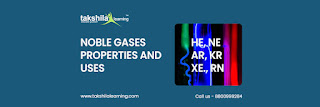What are Noble Gases? Example and noble gases name
Noble gases, sometimes known as inert gases or erosions, are part of the modern periodic table's 18th group. This group is made up of the following individuals:
Helium is a kind of gas (He)
Neon (Ne)
Argon is a gas (Ar)
Krypton (Kr)
Xenon is a kind of xenon gas (Xe)
Radon is a gas that can cause cancer (Rn)
Noble gases exist in a gaseous state under typical temperature and pressure conditions. Because all noble gases have stable electronic structures, they have very little chemical reactivity. They are monoatomic gases that do not readily form molecules.
'ns2np6' represents the basic electrical configuration of noble gases. As a result, noble gases' outermost valence shells can be deemed 'complete.' The chemical inertness of the group of 18 elements is due to this.
Because of the stability of certain elements, these gases form a group. These stable elements' crusts are totally filled. Regardless of how inert or rare they are, inert gases are used in a range of applications.
Examples of noble gases
Helium, Neon, Argon, Krypton, Xenon, and Radon are examples of noble gases.
Noble or inert gases' nonmetallic characteristics
In many ways, inert gases are similar to metals. Even in liquid form, they are colourless, odourless gases with low liquefaction and boiling points and poor heat and electricity conductors. They, like other groups in the periodic table, have a distinct melting and boiling point trend. Although the boiling points go below the group – Radon's boiling point is still -62oC, but they all boil at low temperatures – the melting point and boiling point climb below the group.
Know about the properties of noble gases and their uses
Click for CBSE Online Class 9 Live Classes

Comments
Post a Comment
Thank you we will contact ASAP.